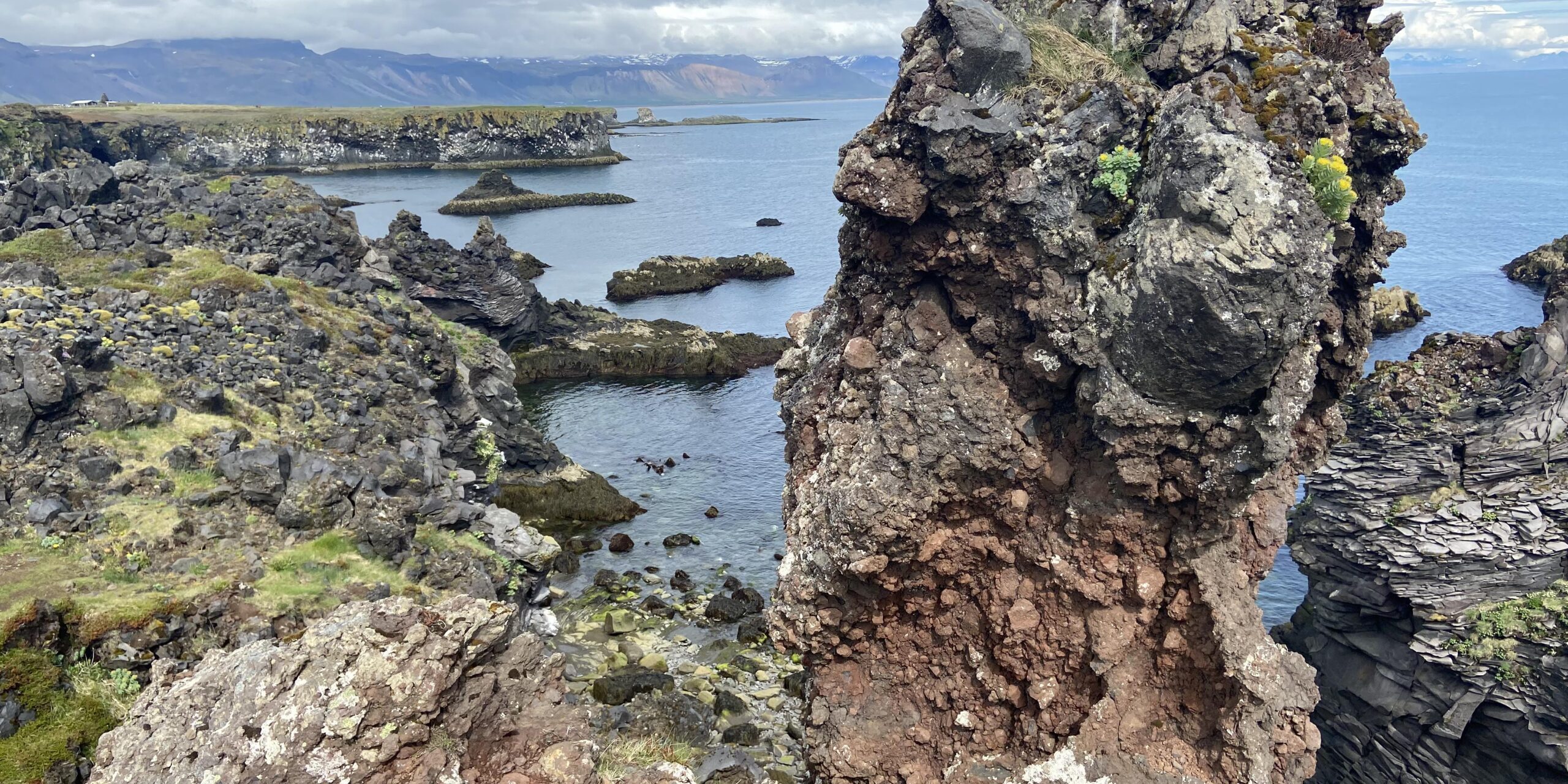An exploration into Iceland’s Hidden Folk
“If I deny elves, I deny my grandmother and mother.”
Pall Ásgeir Ásgeirsson
My disclaimer
I believe there are many perspectives on any one topic, and elves are no different. When approaching this subject, I asked myself, how do I write about elves in a relevant way that remains sensitive to Icelandic customs while including all sides? I decided to include many different sources about elves from several angles and ask anyone who reads this to be open-minded. After all, something brought you to this page. This is the first on many entries to come on the topic of Iceland’s Hidden Folk.
Key terms
Alfár, Hidden Folk, and Huldafölk used interchangeably with elf
Völva – a woman who traveled from village to village offering magical services such as prophecy foretelling and manipulating the future. Practiced seið, a special kind of magic that allows her to communicate with the dead and other unseen beings.
Baðstofa a living room and bedroom in an old Icelandic farmhouse
Freyr- the Norse god of fertility. Gifted the realm Álfheimr as a “teething present” according to mythological lore. Brother to the goddess Freyja, and son of Njörðr, god of the sea.
Distaff is a wand used by Volva, typically made of iron and used to enter trance during magical rituals.
Dokkálfar – the dark elves a different race of elves mentioned in the Prose Edda.
Grimnismál is a mythological poem of the Poetic Edda where Odin delivers his knowledge of mythological lore to a king he is held captive by.
Books of interest
Being Elves-Where by Pall Ásgeir Ásgeirsson
Elves Witches and Gods Spinning Old Heathen Magic in Modern Day by Cat Heath
The Little Book of Hidden People by Alda Sigmundsdóttir
The Guardians of Iceland by Heidi Herman
The Poetic Edda trans. Jackson Crawford
The Prose Edda Snorri Sturluson Penguin House Edition
Witches, settlers, and stories.
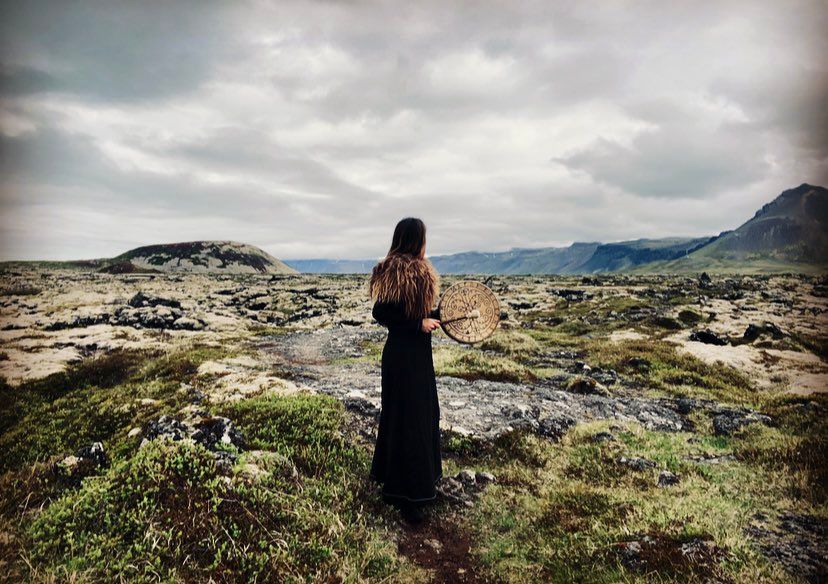
A völva walks across a grassy field. In her left hand she grips her distaff which she plants into the earth. When she arrives at a small hill, she climbs it, stopping only once to whisper these words; “Álfar wise, shining beauty, bright and fair. I weave my words and invite you here.” Upon cresting the hill, she lays in the grasses, concealing herself with her cloak as she does so. Within minutes she falls into a magical trance. Soon she is gone from this place, entering the world of the unseen where she will encounter the Hidden Folk to ask them for their counsel.
A child wanders astray from his home in western Iceland. A storm pounds the coast, bringing with it unrelenting hail and wind, Nightfall arrives, and the child is lost, unable to see the path which is shrouded in a cold mist. His family huddles together for warmth in the baðstofa, waiting for his return. His mother weeps as she explains the only possible explanation, he was taken by the Hidden Folk, taken to a better place where there is food and warmth to live a good life. The family falls asleep comforted by the tale instead of distraught by the inevitable.
Two brothers wander along a cliffside in Dalir, Iceland. As they pass a peculiar rock formation, they hear enchanting music. Nightfall is nearing, and the one brother insists they return home. But his twin is mesmerized by the music and leaves to investigate. He does not return home that evening or the next.
It is nightfall on the last full moon of the year in Northern Scotland. A woman rises above the trees in the darkness, a broom between her limbs gifts her the magical art of flight. She soars above the branches towards a distant village. Affixed to her side body are four poisonous arrows, their destination is those who have wronged her. Down below the elves wait for her return. They are enthralled their arrows will be of good use.
These are just a few examples of elf stories I created based on my research through the years on the topic of elves. There are countless stories of elves in Icelandic, Scottish, Irish, and Norwegian folklore;
Elves who assist humans. Elves who have their own communities with agriculture, technology, and cathedrals. Elves who work with witches, and elves who ask humans for help. Elves who kidnap children, or replace them with one of their own. Hundreds upon hundreds of stories have surfaced through the years and I am certain even more exist, they just have not been published.
So if you are like me and you have heard the word elf thrown around in your travels to Iceland you may begin to wonder, what exactly is an elf and does this race of supernatural beings exist?
Foremost, elves have been an important part of Icelandic customs since the first settlers arrived.
In November 2023, The Reykjavik Grapevine interviewed Terry Gunnell, Professor of Folklore at the University of Reykjavik about elves in Iceland. I liked his answer. Terry makes a good point about how this belief in elves has a huge impact on Icelandic customs and culture, particularly the relationship with nature.
Respecting the land and nature has been a part of Iceland’s culture since The Settlement. This idea was not something just adopted over time, it is rooted in their history, encouraged by the personification of key elements to gods, as well as a belief the land is shared with unseen beings.
The construction of the iconic Blue Lagoon was even halted due to suspicious problems that were believed to be caused by elves who were unhappy with the idea of relocating a large boulder in the lagoon. The construction did not continue until the elves were “consulted.” Plans were agreed upon, and the project continued, albeit without any incident.
The topic of elves is more complex than it appears. Although elves are part of folklore in many parts of the world, it seem to have the most impact in Iceland. Could it be that Iceland just has more elves? Or are Icelandic people more mystical, or treasure the old beliefs more than other places?
So here is my first, of many, posts on elves. Whether elves exist or not is up to each of us to decide for ourselves.
Why elves
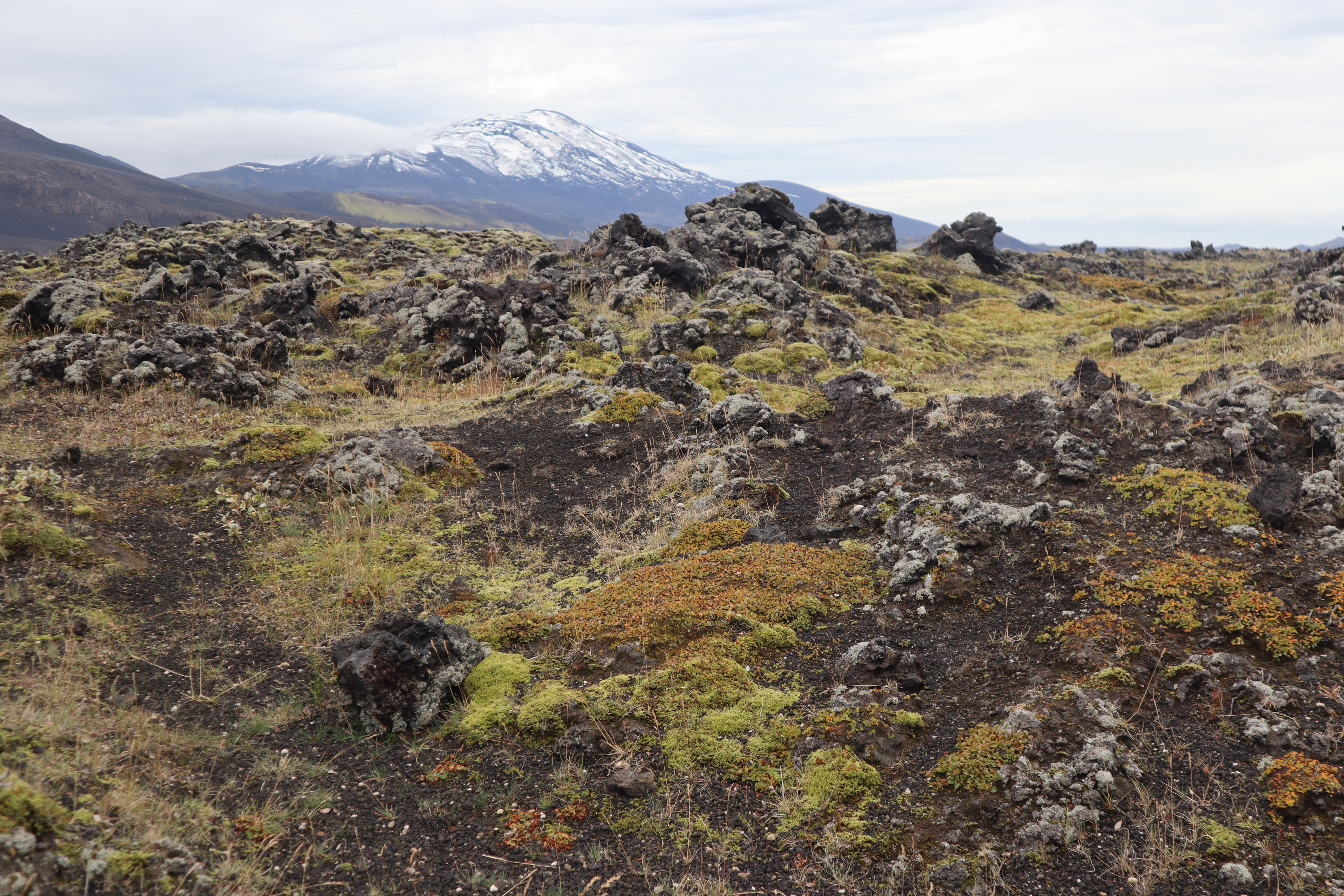
My dive into elves began during my first visits to Iceland. What brought me to Iceland was a desire to intensely research the landmarks and landscapes featured in some of my books. I was intrigued by Icelandic magic and mysticism, and this idea of a race of Hidden Folk who resided in the rocks, yet remained unseen unless they chose otherwise.
During my research I came across many books, all differing in opinions and thoughts about whether elves exist or not. Regardless the books shared the many stories of elf lore in Iceland. The opinion of whether they exist or not ran the gamut of yes, to absolutely not, to yes, and we can work together with them.
Such books like “Being Elves- Where”, make it clear to deny the elves is to deny their ancestors, and just because we don’t see something doesn’t mean it doesn’t exist. A differing opinion is offered in the book “The Little Book of The Hidden People” written by Alda Sigmundsdottir. The author states that elves were nothing more than a coping mechanism created by the first settlers to explain missing children and terrible weather.
On the other hand, the book “Elves Witches and Gods, Spinning Old Heathen Magic in the Modern Day” by Cat Heath takes a very deep dive into not just what an elf is, but how to honor and work with the elves through traditional Heathen magical practices. Do I believe in elves? I will answer that later. The question is, will you?
What is an elf?
First, elves are not little men with pointed hats and shoes portrayed in the anglophone world.
I am going to cite different texts here because I don’t really know for a fact what an elf is. I have never seen an elf, but this doesn’t mean I have not encountered what I believed was one.
My definition of an elf would be something like “ an unseen spirit who resides in the land and protects it, they are aware of us, yet we may not be of them”
This is the definition I chose to believe. Humans are logical for the most part. We like to make sense of things, our brains are designed for it. Coupled with the bias we develop as we age, this makes it difficult to fathom a race of unseen beings exists.
Which leads me here, liminality. Elves can be filed in the liminal category in a sense where this idea of an unseen race of advanced beings existing is far beyond the boundaries of what most of us are raised to believe. So to try and understand what an elf is, we have to cross over this threshold, and for some this is uncomfortable.
After all, we are exploring a subject that is more in the mystical realm, than scientific. More magical, than proven fact in a sense we don’t have any archeological evidence of elves, at least that I am aware of.
We do however have objects like an exquisite cloth gifted from an elf to a farmer’s woman preserved in a National Museum. Or a book written about an elf garden in Iceland by an elf. Or a crucifix bravely saved from a fire in Iceland due to it being sacred to the elves. And what about all the accounts of elves given by people? Are they to be dismissed?
Some people are more mystical and superstitious than others. This is by no means a bad thing. Perhaps it is the way we are raised, or an experience or just a choice.
For some not believing in magic makes life easier, for others the opposite holds true. For some the idea of Hidden Folk living amongst us is terrifying, and I get that, whereas for others, it’s exciting.
I am in the excited category. I also want to point out that the Icelanders I have encountered, are pretty open-minded people. I can recall several times I told a few Icelandic friends about a prophetic dream I had and they didn’t even blink an eye as if I had told them what kind of bread I got at the bakery.
The best way for me to describe what an elf is to you is to cite some sources of what an elf is, because I have never seen an elf. But this doesn’t mean I haven’t encountered one…wink. So here goes:
- “The simplest way to answer this question is that they all tend to have the same characteristics. An Álfar can seemingly be of any origin and can come from many different places if they demonstrate sufficiently elven traits. We have already covered the main characteristics of elves to some degree on the discussion of Freyr. In the older sources, elves are inherently connected with sexual deviancy, fertility, and the mound. And like Freyr they were often depicted in partnership with witches as a possible source of supernatural power as well as prophetic knowledge.” Heath, Cat Elves Witches and Gods Spinning Old Heathen Magic in the Modern Day pg 59
- The easiest way to answer this question is, elves are elves. – Ásgeirsson, Pall Ásgeir Being Elves- Where pg. 8
- “Iceland’s folklore at its core reflects the plight of a nation living in abject poverty on the edge of the inhabitable world and its people’s heroic efforts to survive, physically, emotionally, and spiritually. That is what the stories of the elves or hidden people are really about.” Sigmundsdottir, Alda The Little Book of the Hidden People pg 10
- “According to Icelandic folklore, the hidden people were the original settlers driven underground by the arrival of human settlers. The hidden people are said to have retreated to the mountains and remote areas of the country where they live until this day.” – Van der Meersch, Gitte The Reykjavik Grapevine Nov 16, 2023″According to Icelandic folklore, the hidden people were the original settlers driven underground by the arrival of human settlers. The hidden people are said to have retreated to the mountains and remote areas of the country where they live until this day.” – Van der Meersch, Gitte The Reykjavik Grapevine Nov 16, 2023
Elves are mentioned in both The Poetic and The Prose Edda, collections of stories concerning the Norse gods, heroes, and other inhabitants of the Nine Realms of Norse Cosmology.
- In the Poetic Edda, section Grimnismál, (the words of Odin in disguise) Odin is held captive by a king he once favored where he delivers his knowledge of mythological lore. In this poem we are given a framework of the cosmos, as well as the many halls of the gods and goddesses. In Stanza 6, Odin states “The gods gave Frey(r) the land of Álfheim (elf land) long ago, as a gift in his youth.” (trans. J. Crawford) This connects the god Freyr to the elves and thus establishes this “type” of light elf hails from Álfheim.
- In the Prose Edda, Icelandic historian and poet Snorri Sturluson writes about two different races of elves; the Ljosálfar ( light elves) and the Dokkálfar (dark elves) who both hail from different places.
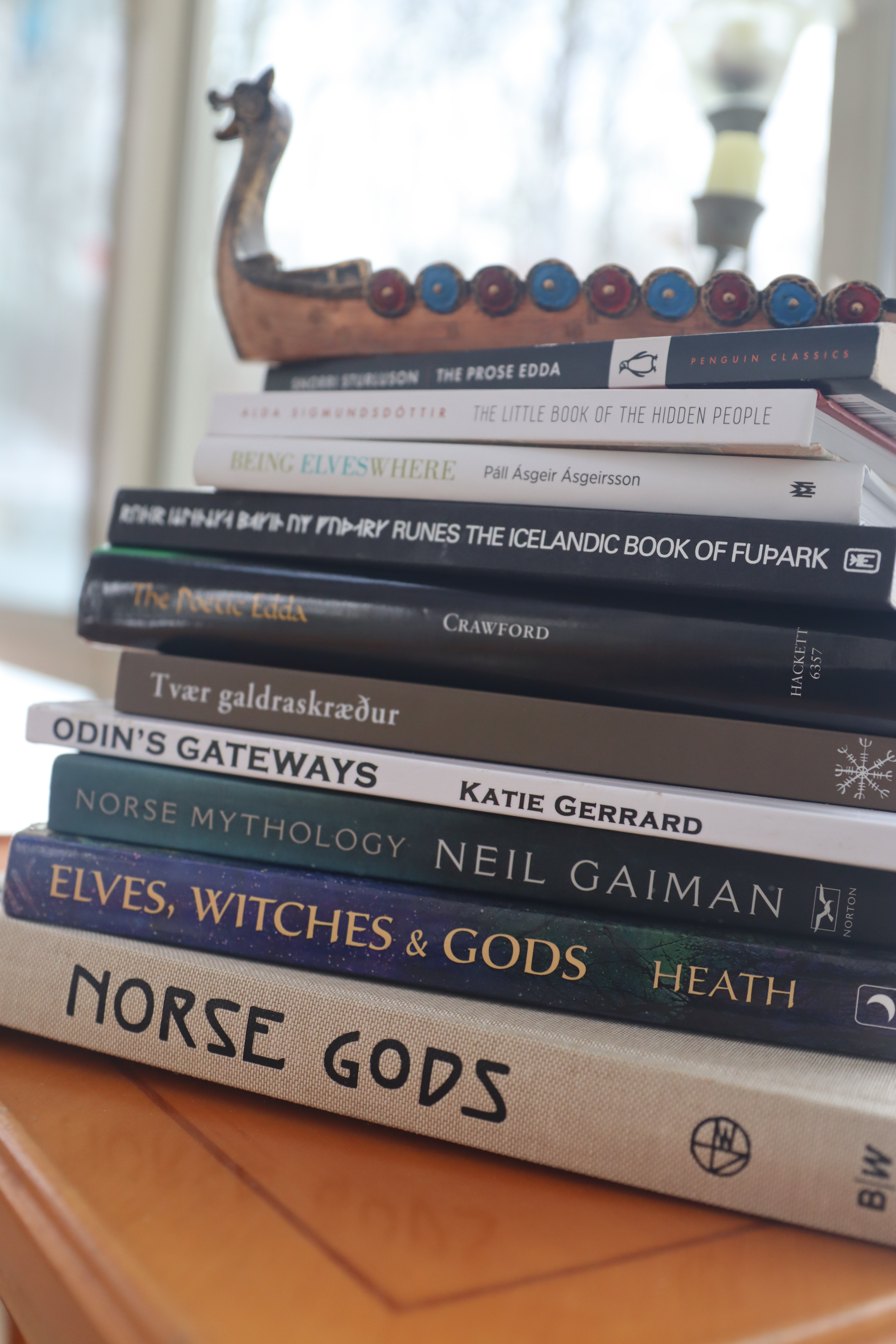
According to folklore, elves can choose to be seen by humans when they want to be. There is even a magical ointment they will rub on a human’s eyes to make them psychic. Then that person be able to see the elves and their communities. (Ásgeirsson).
It was also believed if a child did not get holy water in their eyes when christened they could see elves.
So where did they come from?
Origin of the elves
There are several stories behind where the idea of elves or elves themselves comes from. As stated above, both The Prose and Poetic Edda describe a place called Álfheim where the light elves hail from. But where did these stories originate from and how did they end up in Iceland?
According to Icelandic custom, the elves were the original folk who resided in Iceland and retreated into the land once the settlers arrived. We know this idea of elves existed during the ages of the Icelandic sagas. In Iceland’s most famous saga, Njall’s Saga, a person is compared to an elf.
In legends, the origin of the elves varies.
One folktale describes the first elves as the unclean children of Adam and Eve. Eve was preparing her home for a special visitor while her children are playing in the garden. When the children arrive home they are covered in dirt, and so Eve, embarrassed, sends them away to hide in the gardens until the visitor leaves. The visitor is enlightened to this and utters the words; “Whatever shall be hidden from me shall be hidden from all people.”
Later in the evening when Eve ventures out to call her children home, she is shocked to learn she can no longer see them. The children could appear to her if they wished or remain invisible. Thus, these children stayed living in the gardens, growing further away from humanity as time passed, yet closer to nature. These children became the first Hidden Folk.
As discussed earlier, light elves are mentioned in both the Poetic and Prose Edda who hail from a place known as Álfheim. Unfortunately not much information is given about Álfheim besides that it translates to “elf world.”
In Elves, Witches, and Gods, Health alludes to Freyr, as the elven king. In Grimnismál, Odin states Freyr is gifted Álfheim, thus Heath theorizes this makes Freyr the ruler of these types of elves (light elves.)
In Being Elves-Where, Ásgeirsson points out the striking resemblance between the Icelandic elf traditions and those of West Norway and Ireland- Which happen to be the same regions Icelanders have their roots. This suggests the belief that elves came to Iceland from these regions with the Settlement.
Although I am mostly of Celtic descent, I have not done much research yet on the mythological beings known as fae or elf lore in Ireland, but I have heard from several people who reside in Ireland there are striking similarities between the stories concerning the Irish fae and Icelandic elves.
What is an elf like?
We have an idea now of where elves come from, but what are they like?
As mentioned, there are two races of elves described in the Edda. The Dokkálfar or “dark elves” are the smiths also referred to as dwarves, and differ greatly from the race of “light elves.”
As far as I know, Icelandic elves are closer in kin to the “light elves,” and so far my research has not proved that wrong. I would like to talk further on this topic with an Icelandic seer, or someone who has claimed to have a close relationship with Hidden Folk. On a few occasions I have gotten the idea that the word “Huldafölk,” encompasses many kinds of land spirits, and not just light elves.
- In Being Elves- Where, elves are described as “serious and demure”, as well as “good-natured, modest, and helpful. Yet elves are not beyond avenging themselves on humans who wrong them though stories of such interaction are much rarer than stories of good-natured interaction where elves help people who are in difficult situations….”
- According to those who claimed to have seen an elf, the consensus is they are good-looking and well-dressed, ( often in colorful clothing).
- They are sometimes described as having narrow faces, a missing septum, and a bit shorter than humans (although this varies as does body type).
- In Elves Witches and Gods, Heath describes elves as “mostly masculine but like the way the god Freyr is described.” Here is what she writes:
“They are inherently masculine, yet challenge traditional ideas of masculinity with their reputation for beauty as well as conventionally effeminate traits and behaviors,” Heath, Cat Elves Witches and Gods Spinning Old Heathen Magic in Modern Day pg 59
- Elves are well-dressed. (Ásgeirsson) According to folklore, their clothing is colorful and bright.
It seems the descriptions of what an elf looks like vary when you read the accounts of elf encounters. So come to think about it, maybe I have met an elf and I just didn’t know…
Where do they live?
According to folklore, traditionally elves live in rocks, hills, and stones. Elf dwellings are described as “towns that may reside in a rocky area that appears to be a grassy mound.”
It is believed they do not reside in lava rock, although there was a dispute once about building a road through the Garðahraun lava field due to it being a disruption of elf dwellings.
In Being Elves -Where, Asgeirsson lists several known places believed to be inhabited by elves, which include libraries, cathedrals, and concert halls. Included are the GPS coordinates for each location. Don’t expect to go to Iceland and see a sign stating “elf church,” although some peculiar rock formations are named Álfarkirkja (elf church). In my experiences, these places are often difficult to locate, and with good reason.
Now with Hidden Folk living within the rock, they must have very little, be simple-minded, and not understand technology right? Wrong.
Elves are believed to have considerable amounts of livestock, can read and write, are keen on technology, and possess special magical abilities little known to humans. I read one account that states elves even have cars!
Do Icelanders believe in elves?
Er, kinda, sorta, maybe, yes, and they won’t deny it.
A survey conducted in 2011, cites 41% of Icelanders believe in the possibility of elves, 18% said it was likely, whereas 11% are convinced they do exist. That’s 72% of Icelanders believe elves do exist to some extent. (Ásgeirsson, Being Elves-Where)
During the settlement days, it was believed elves could bring good fortune or misfortune, that all depends on you. So imagine this; Iceland is a harsh place. In fact I cringe when I read the stories of the first settlers, huddling together for warmth in lice infested turf houses, scraping together whatever stock they had left with only a glimmer of hope they would make to the spring. Then boom, a volcano erupts and everything is grim.
If you are this farmer and you know if you do. not have a successful harvest you and your family will die, and that leaving offerings to the elves may, just maybe a small chance even, ensure a good harvest, you are going to do it.
This is my opinion and perhaps some truth lies in this; If this is how Icelanders survived for a very long time, through plague, eruptions, harsh winters, and starvations, and these stories either were true or just gave them hope, they are a most sacred part of their history.
Circling back to the article on elves published by The Reykjavik Grapevine in November, 2023. They had spoken with Terry Gunnell a professor of Folklore at the University of Reykjavik, who made an interesting statement on the psychological impact of the belief in elves.
“For some, the belief in hidden people is a way of maintaining a connection to the past and their cultural heritage, for others, it is a way of coping with the stresses and uncertainties of modern life.”
I’d say that is a pretty damn good reason to hold on tight to this custom.
You can access that article in its entirety here.
Points of elf interest in Iceland
Okay, you made it this far, which tells me, you may believe in the possibility of elves. Now if you are planning a trip to Iceland and investigate a little further, maybe even explore some “elf locations,” here are some. I would also highly recommend you look into purchasing these two books on Icelandic elf folklore:
Being Elves – Where by Pall Ásgeir Ásgeirsson which you can purchase at the Keflavik Airport bookstores or any bookstore in Iceland.
The Little Book of Hidden People by Alda Sigmundsdóttir
The Elf Garden. In Hafnarfjordur, ( N. of Reykjavik) there is an elf garden you can visit. The garden was once supervised by Ragnhildur Jonsdóttir who is described as a “spokesperson for elves in Iceland.” At one point you could even schedule a tour with her. Unfortunately the website when I checked is down but I did pay a visit the garden during my trip in spring of 2021 with a good friend who also has an interest in elves.
Hafnarfjordur is a lovely town and you can spend a day sightseeing and grabbing lunch or coffee and Icelandic pastry. I enjoyed a latte at Súffistin.
The Elf School. If time allows you can visit the special elf school in Reykjavik. Their website is www.theelfschool.com/schedule and offers some information on elves, as well as a weekly schedule.
Asbyrgi Canyon- a majestic natural phenomenon in N Iceland is believed to be a place where elf concert halls reside GPS coordinates: 66.0178° N, 16.5055° W
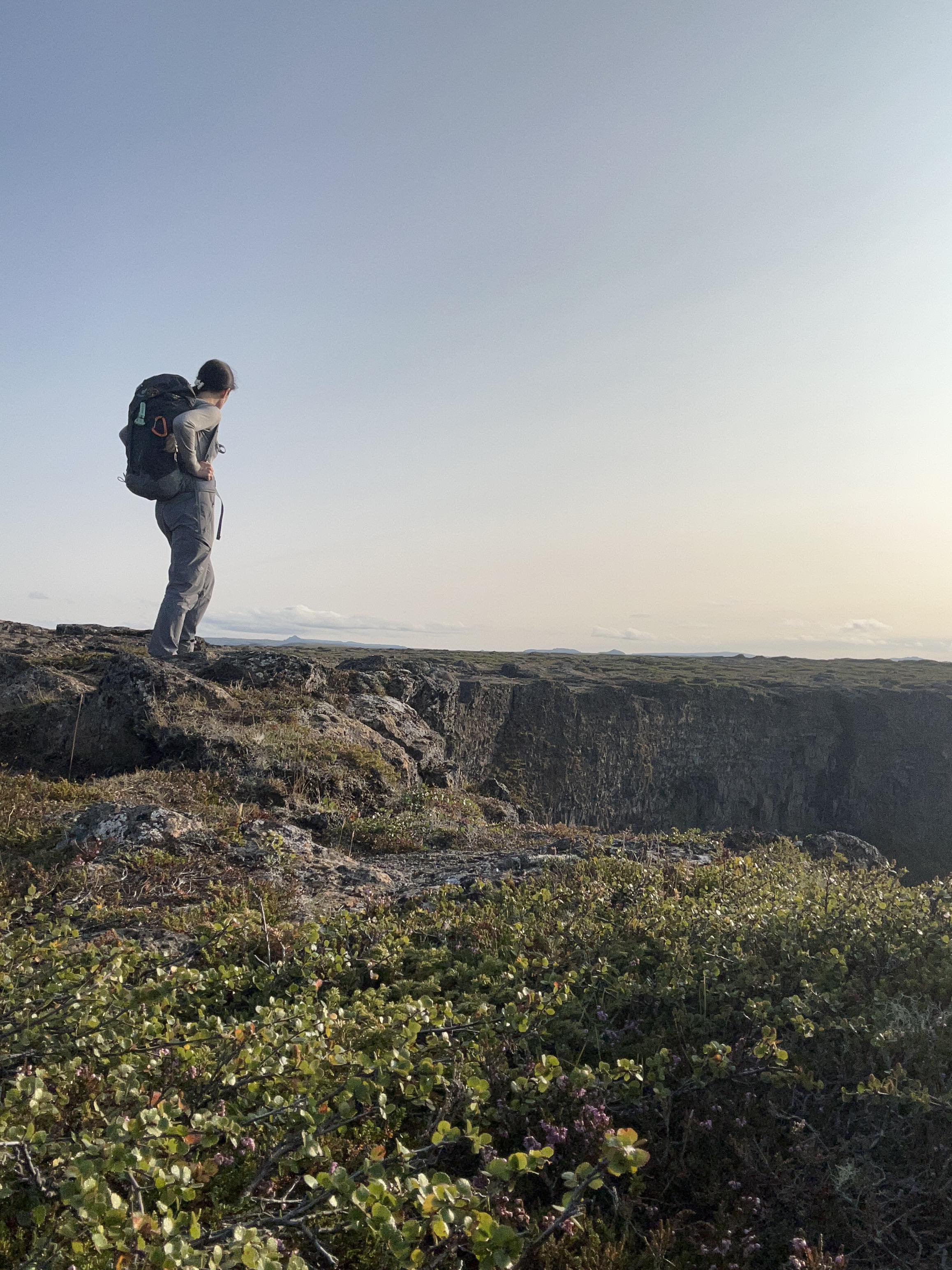
Arnarstapi to Hellnar hike Along the way be aware! GPS coordinates: 64.7507° N, 23.6465° W
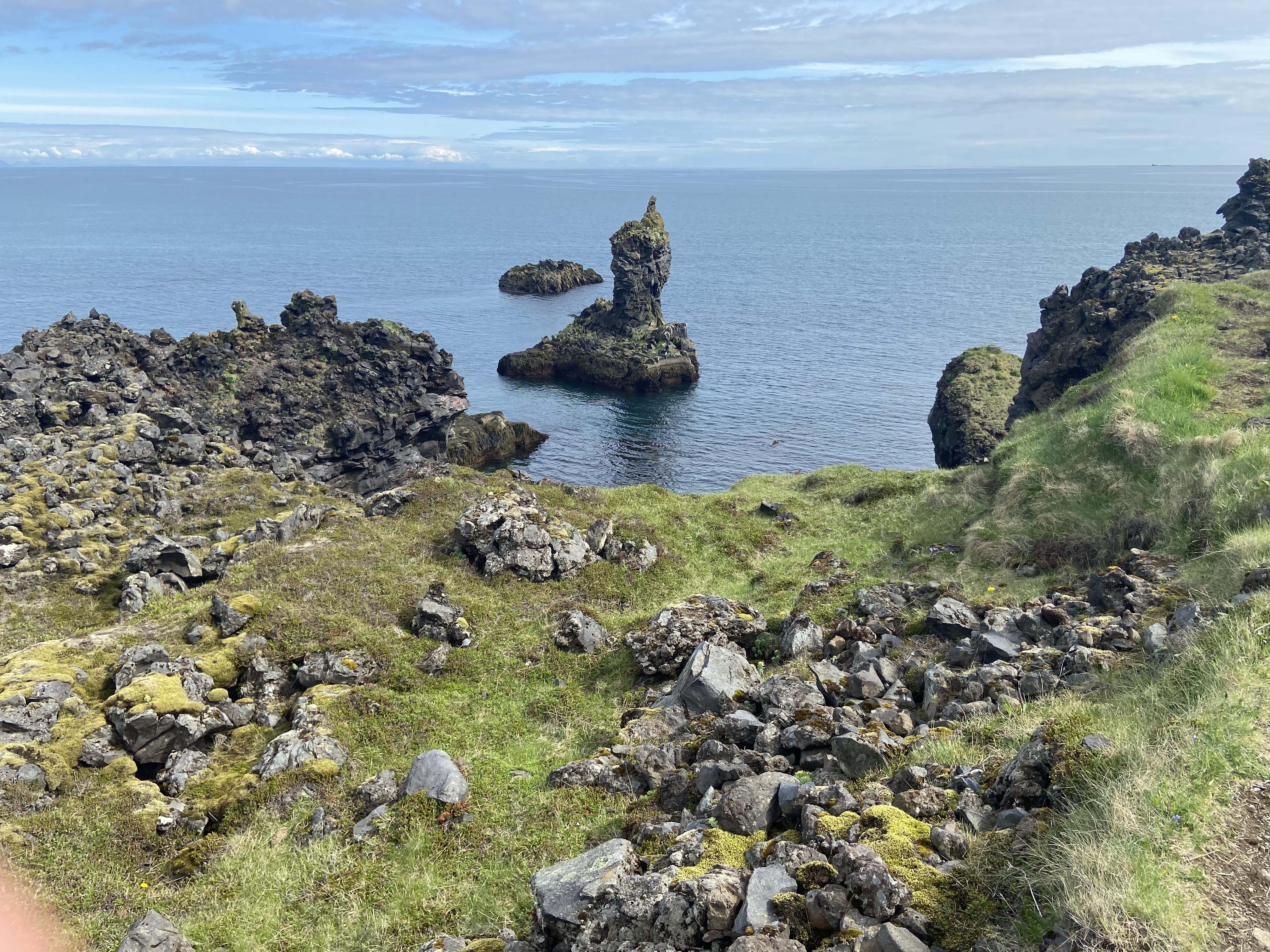
The boulder behind Bustarfell farm in Vopnarfjorður is where a farmer’s wife was asked to assist an elf. The elf gifted the woman an exquisite cloth which is now at the National Museum GPS : 65.6152928 N, -15.1020169 W.
Londrangar pillars in Snæfellenes contain elf habituation GPS coordinates: 64.732381, -23.784827
Tungastapi in the mouth of Sælingsdalur in Dalir is considered an elf cathedral (I wrote a short story about this that I will share here soon!) This one is tricky to find but it is not too far from Guðrunlaugur so be sure to stop there if you have an interest in the sagas and the hot spring. You can read more about Guðrunlaugur here.
You may want to know, do I believe in elves?
I have visited Iceland six times in three years, wow, that is a lot when I think about it! It makes sense that one may want to know if I, with all this time spent there in nature, believe in elves.
Yes, I do.
I had too many experiences on this little island to lead me to believe anything but there are unseen forces in the land. Whether it is a race of beings much like us with their infrastructures and farming, or something else, I don’t know, but there is something.
I’d like to tell these stories, one day, maybe here, maybe to just a few more people. But for now, I keep them close to just me because that is maybe they were only meant for me.
Regardless if elves exist or not, the belief in them or the possibility of it, encourages harmony and connection for nature. Gunnell states in his interview with the grapevine that the belief in hidden folk will persist as long as there are people who feel connected to the land and nature. But with the influx of western culture influence on Iceland, the future of preserving old customs may be at threat.
Dear Icelanders, I implore you to not allow this to happen. Whether you believe in elves or not, your customs are special, unique, and what brings the charm to your country. Please don’t lose this.
For visitors to this special country:
- If you desire to connect with the hidden folk, the best way to do so is to lay in nature and be still and quiet.
- When you see an elf house, or hear a story of elves on your visit, I encourage you to keep an open mind. Don’t litter, don’t take anything from the land you are not supposed to, respect nature, and don’t poke fun about the elves to an Icelander.
- If you have visited Iceland or planning on it, share with me your thoughts on elves or experiences that led you to believe or not in them!
As the saying goes, the most beautiful things are not always seen with the eyes but felt with the heart. And this does for the Hidden Folk as well.
Thank you for reading!
This topic isn’t over! I plan on sharing more stories concerning elf folklore and expanding more on all that is magical and mystical about Iceland! I would never expect to wrap up on topic such as elves in one blog post, there are just so many sides to these stories and to do that would discredit the belief and customs themselves.
You can expect future posts to include information on “elf customs,” Icelandic holidays that are rooted in folklore, as well as folktales themselves. I also plan on returning with more on this when I attend the Icelandic Festival for Sorcery and Witchcraft in April.
If you enjoyed this post, please throw me a follow here and on Instagram where you can stay in the know when I share and tag along as I continue exploring my favorite place.

